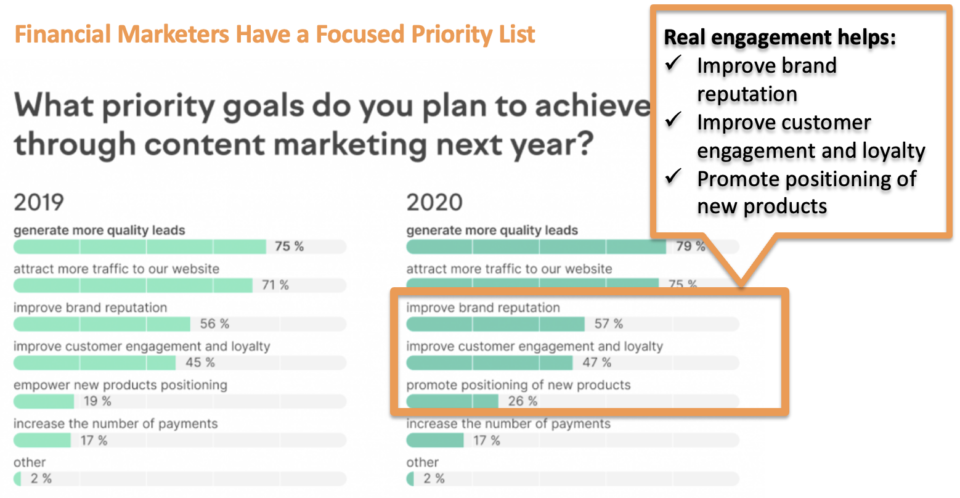

This year, how about doing less but still managing to do more?
As the pandemic wears on (and on and on), so many of us are trying to inch our way back to normalcy, even though our working conditions are still far from normal. While I await a vaccine-shaped envelope that says “MARSH” on the front, I’m trying to keep myself laser-focused on doing the bare necessities well.
For instance, as a pandemic-working-virtual-schooling-parent, I have a stack of personal metrics that I’d love to check off every day – work, kids’ schoolwork, healthy meals, clean home, adequate exercise, safe socializing, a spigot of library books. But that’s too much for pre-vaccine 2021. So instead, I have to prioritize a smaller sub-list. Key deadlines done, math assignments finished, dinner that is not made of Doritos. The metrics list has to be reeeeeeal short.
Metrics That Matter in Financial Services
Similarly, content marketing — while extremely valuable — is one of those zones where the list of what you would like to achieve is just not doable at the moment. In a best-case scenario, you would probably like to have a fully reported ROI, along with a nice long list of trackable and useful metrics. You can track lead quality. Sales deriving from content. Web-traffic numbers. SEO effectiveness. Exposure and authority scores.
But that’s too much for a pre-vaccine 2021. So it’s time to narrow it to the do-less version. What is that version for financial services marketers? Probably this: engagement.
Engagement: The Key Zone for Financial Services Marketers
For asset managers and the other financial companies that hire people like me, content is foremost a tool of engagement.

It’s not intended to float virally around the internet via Twitter and Facebook shares, or to bring tons of new retail traffic through the website. It’s meant to engage current clients, bolstering their trust. It’s also meant to show the slimmer funnel of prospects that the group they’re vetting is sharp, on top of things and reliable.
Tracking Engagement in 2021
With engagement in mind, focus in on a shorter list of metrics. Look especially at tracking the amount of time that your audience is spending on your content and what they do next. If you haven’t already, make friends with Google Analytics.
Figure out who your audience of interest is — for my business, for example, I care most about the U.S.-based people who find me on Google. They are the prospects for my financial writing business. I care about how many there are monthly, what their bounce rate is, how long they stay on my website, and how many pages they visit. Four metrics — that’s it. That tells me if they are engaging sufficiently with the content that I put out publicly.
As you publish content through 2021, try tracking a very short list of metrics like this, per piece. Find out what your starting point is and from there, you can start to chip away at your most important goals.
Tracking Engagement If You AREN’T the Marketer
Hey you, all the people in the audience who aren’t marketing directors – this concerns you too.
Many of you are investment professionals or other practitioners, people who contribute to content and hope it does well internally or externally.
You, too, should be focused on engagement. Every single organization that produces content really NEEDS its subject matter experts, the people with the points of view and insights. Volunteer to make some content this year, and figure out how to track the engagement in your own sphere.
Looking for an experienced freelance financial writer to help with engaging content? Reach out and let’s talk about your project needs.
Carolyn is a freelance financial writer with 15+ years of experience in financial services. She holds an MBA from the University of Chicago Booth School of Business and is a CFA charterholder. She writes from Washington D.C.
Posted By
Carolyn
Categories
Compound Return Newsletter, Content Marketing, Freelance financial writer